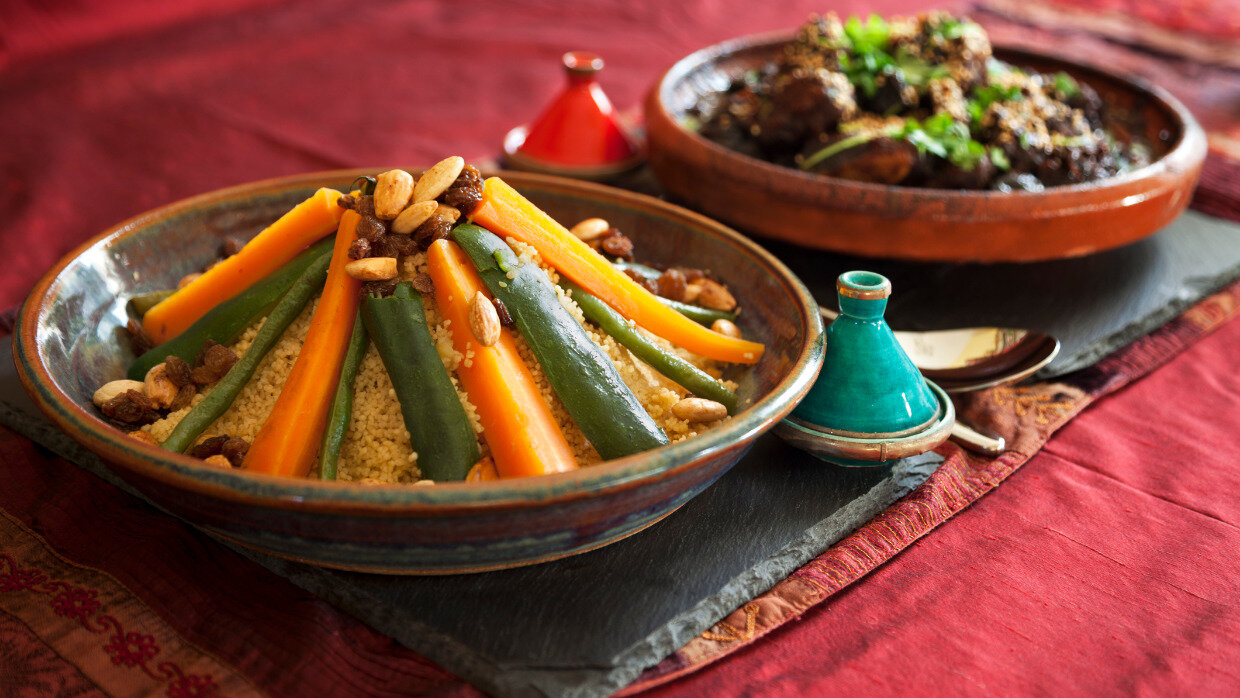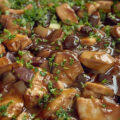In Moroccan spice markets the aromas are potent. The sound of store owners shouting prices and the sea of people coming in and out is an almost surreal experience. But when we zoom out, we see that all that chaos is necessary to make the incredible flavors of Moroccan food possible.
The history of the Jewish community in Morocco dates back to ancient times. According to some historical accounts, Jews have been living in Morocco since the Roman era. Morocco is a country that boasts a rich and diverse cultural heritage, and its Jewish community has played an important role in shaping the country's history and cuisine.
However, the largest influx of Jews came in the 15th century, when they were expelled from Spain during the Spanish Inquisition. Many of these Sephardic Jews settled in Morocco and brought with them their culinary traditions and recipes.
Essential Ingredients and Dishes

In Morocco, meals frequently feature vegetables or fish and couscous and are seasoned with flavorful herbs and spices like cumin, saffron, turmeric, ginger, and cinnamon.
One of the key ingredients unique to Moroccan Jewish cooking is preserved lemons, which are used to add a tangy flavor to many dishes.
Another common ingredient in Moroccan cooking is harissa, a spicy red pepper paste that is used to add heat and depth of flavor to any dish.
One of the most popular Moroccan Jewish dishes is tagine, a slow-cooked stew that is traditionally cooked in a clay pot of the same name. Tagine can be made with a variety of ingredients, such as chicken, lamb, or vegetables, and is typically flavored with a combination of spices, including cumin, coriander, turmeric, and paprika.
Another popular Moroccan Jewish dish is b'stilla, a sweet and savory pastry that is typically filled with chicken or seafood and flavored with cinnamon, almonds, and powdered sugar. B'stilla is traditionally served at weddings and other special occasions.
Moroccan Jewish cuisine also features a variety of breads, such as khobz, a flatbread that is typically served with stews or used to scoop up dips and spreads.
Holidays in Morocco
Similarly to how Eastern European Jews used anything and everything they had available to them to make cholent for shabbat, Moroccan Jews adapted Moroccan cuisine to Jewish holidays and events.
Dafina is their version of cholent which instead of combining all the ingredients in the same pot and cooking overnight, each ingredient is separated into a bag and cooked separately so that each element of the dish has its own unique flavor.
The Moroccan holiday of Mimouna, which happens every year on the day after Passover is celebrated by eating an exorbitant amount of carbs. One special dessert served on Mimouna is Mufleta. Which is a thin crepe like pancake normally served with butter and honey (or nutella if you're feeling fancy).
Many Moroccans have a tradition of saying 100 blessings a day, and due to there being fewer blessings in morning prayers on Shabbat, Moroccans have a special custom of making a full appetizer course to start their meal. In most Jewish traditions, people eat their meal freely after having made the blessing over bread. No other blessings are required until the blessing at the end of the meal.

Moroccans, on the contrary, make kiddush on wine and then make a blessing on each appetizer and salad before the blessing on the bread. By doing this they are able to reach their goal of 100 blessings and get to enjoy some pretty delicious appetizers.
Jews in Morocco
Moroccan Jews have also made significant contributions to Moroccan culture and society. During the 7th and 8th centuries, Jewish people began to migrate to North Africa, being granted safe residence despite the rise of Islamization. The Jewish people introduced the Moroccan people to various pickling and preservation techniques for fruits and vegetables. In addition to their culinary contributions, they helped shape the culture in Morocco and imbued Jewish values to wherever they went.
At the height of Moroccan Jewry, the population grew to between 250,000 to 350,000 and remained one of the largest Jewish communities in the Muslim world for hundreds of years. In fact, there are reports that Jews have lived in Morocco for more than 2,500 years, outlasting the Arabs in the region. But today, only 2,000 or so Jews remain.
Many Moroccan Jews have been successful in business and politics, and have played an important role in the country's development and modernization. With Andre Azoulay, a Jew, even being named the senior advisor to the King of Morocco.
Despite their contributions, the Jewish community in Morocco faced a number of challenges throughout history. With thousands of Jews being murdered all across Morocco. The rampant anti-semitism continued for years before reaching an all time high with several anti-Jewish riots in the late 1940’s which led to many Moroccan Jews deciding to emigrate to Israel and other countries due to political instability and economic hardship.
While it’s clear that Moroccan Jewry left a large cultural footprint on Morocco, nowadays Jewish Moroccan heritage and cuisine is mostly confined to the Moroccan population living in Israel today. At the various family owned restaurants dishing out couscous and Moroccan frena breads with countless bowls of Moroccan salads to eager Israeli restaurant-goers.
Moroccan Jewish cuisine is a testament to the country's rich cultural heritage and the blending of Jewish and Moroccan traditions. Whether you're enjoying a bowl of tagine or savoring a slice of b'stilla, the flavors and aromas of Moroccan Jewish cuisine are sure to transport you to a chaotic world of exotic spices and daring flavors.

















